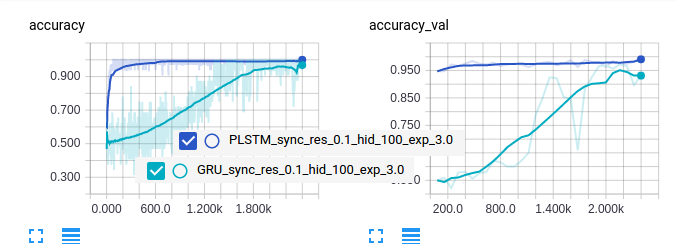Welcome to the Tensorflow implementation of the recently introduced Phased LSTM by Neil et. al @ NIPS 2016
You can find here the original implementation from Daniel Neil (in Theano)
Here is the results of frequency discrimination at high resolution sampling (described in the paper): in dark blue you see PLSTM that converges way faster then GRU (in light blue)
Here I implemented the PLSTM in a plug-and-play fashion such that if you wanna use it in one of your models you can switch from LSTMCell/GRUCell to PhasedLSTMCell.
The core of the PLSTM is
tau = vs.get_variable(
"T", shape=[self._num_units],
initializer=random_exp_initializer(0, self.tau_init), dtype=dtype)
r_on = vs.get_variable(
"R", shape=[self._num_units],
initializer=init_ops.constant_initializer(self.r_on_init), dtype=dtype)
s = vs.get_variable(
"S", shape=[self._num_units],
initializer=init_ops.random_uniform_initializer(0., tau.initialized_value()), dtype=dtype)
# for backward compatibility (v < 0.12.0) use the following line instead of the above
# initializer = init_ops.random_uniform_initializer(0., tau), dtype = dtype)
tau_broadcast = tf.expand_dims(tau, dim=0)
r_on_broadcast = tf.expand_dims(r_on, dim=0)
s_broadcast = tf.expand_dims(s, dim=0)
r_on_broadcast = tf.abs(r_on_broadcast)
tau_broadcast = tf.abs(tau_broadcast)
times = tf.tile(times, [1, self._num_units])
# calculate kronos gate
phi = tf.div(tf.mod(tf.mod(times - s_broadcast, tau_broadcast) + tau_broadcast, tau_broadcast),
tau_broadcast)
is_up = tf.less(phi, (r_on_broadcast * 0.5))
is_down = tf.logical_and(tf.less(phi, r_on_broadcast), tf.logical_not(is_up))
k = tf.select(is_up, phi / (r_on_broadcast * 0.5),
tf.select(is_down, 2. - 2. * (phi / r_on_broadcast), self.alpha * phi))then the kronos gate is applied to the cell simply by
c = k * c + (1. - k) * c_prev
m = k * m + (1. - k) * m_prevPhasedLSTMCell has the same parameters set has the LSTMCell plus, here I report the default parameters (as indicated by the paper)
- The slope in the off period of the gate
alpha=0.001- The initial value of r_on
r_on_init=0.05- The parameter for the initial sampling of tau
tau_init=6.tau is sampled as ~exp(uniform(0, tau_init))
The current implementation uses Tensorflow 0.12.0. If you don't wanna update Tensorflow (BTW you should :)) I inserted in the code some commented lines to be backward compatible.
In PLSTM
initializer=init_ops.random_uniform_initializer(0., tau.initialized_value()), dtype=dtype)
# for backward compatibility (v < 0.12.0) use the following line instead of the above
# initializer = init_ops.random_uniform_initializer(0., tau), dtype = dtype)In the unit test
sess.run(init)
# for backward compatibility (v < 0.12.0) use the following line instead of the above
# initialize_all_variables(sess)Remember also to change the summaries calls, that is:
tf.summary.scalar -> tf.scalar_summary
tf.summary.histogram -> tf.histogram_summary
tf.summary.FileWriter -> tf.train.SummaryWriter
tf.summary.merge -> tf.merge_summary I implemented the first task described in the paper, that is frequency discrimination. The network is presented with sine waves and has to discriminate between waves of a target range of frequencies (e.g. 5-6 Hz) and waves outside of this range. Furthermore there are three different ways in which you can sample these sine waves:
- Low resolution (1 ms)
- High resolution (0.1 ms)
- Asynchronously
The 3 ways are implemented and you can select them with the flags.
Added a builder for multilayer PLSM
outputs = multiPLSTM(_X, lens, n_layers, n_hidden, n_input)Let me know if you encounter any problem: enea.ceolini@gmail.com
+Enea
